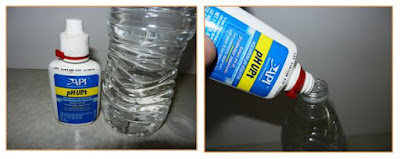You can buy a ph up water adjuster from any major pet shop. To change the ph of tap water, put 3-4 drops of the ph up water adjuster in one standard size water bottle.
Pure water has a pH of 7, which is neutral. Higher numbers indicate alkaline water, the greater, the more alkaline. Lower numbers indicate acidity, the lower the pH, the more acid. Plants, each being adapted to some of the wide variety of conditions found on earth, have certain preferences in pH for rainfall and soil conditions. The pH does have an effect on plant growth.
Nutrient
Availability
Many of the elements most used by
plants in their growth are less available when the pH is in the acid range,
below 6, and many of the micronutrients, those used in small quantities, are
less available when the water, or soil, is alkaline. Some plants prefer, even
require, acid soils and are not bothered by the lack of nutrients. Other plants
will tolerate, but do not require, pH levels above 7, and are adapted to the
lack of micronutrients, such as iron and zinc.
Testing the alkalinity of the water
Preparing your seed bed
Get a clear plastic "food to go" container. Put paper towel(s) at the base of the food container as shown in the picture. Water the paper towel with the conditioned water.
Germination is the process by which a plant grows from a seed. The most common example of germination is the sprouting of a seedling from a seed.
Any seed that has a hard covering like a mango, it is best to removed the outer hard core as shown in the picture below. The same goes with citrus seeds like lemon, kalamansi. Peeling the outer covering will hasten the seed germination process.
Lay the seeds on top of the wet paper towel. Cover the seed with another paper towel on top of the seeds and water the paper towel again. Close the cover of the plastic food container and put a label indicating the date you planted the seeds. Wait until the seeds germinate, put the food container near a window inside the house under indirect sunlight. Water the seed bed when it becomes dry. Frequent watering maybe needed when roots and plant starts to germinate.
- Most effective natural method of propagation in many plants
- Seed propagation increases genetic variation forming hybrids with superior qualities
- Effective for producing virus free plants
- A method of storing plants for a long time without losing its viability
Is there a simpler or faster way to plant the seed?
The answer is YES!
However, the above process of germination has some advantages:
1. Controlled climate inside the house specially during winter.
2. You will be able to pick the right, ideal and healthy plant for your double root stock
3. You will be able to observe and establish the time frame of the seed development and eliminate guess work if the seed is active, alive or dead.
The shorter way to do seed germination is to plant the seed directly into a potting soil. I would suggest that you plant two to three seeds in one pot of each variety of seed that you intend to make as your double root stock. Not all the seeds that you will plant will successfully germinate. In this way, if you planted three or more seeds into a pot, then there is a strong probability that you will be able to get two to three seeds to germinate. Remember you need two or more plants to do a double root stock or multiple root stock. See pictures below.
Other methods of germination:







